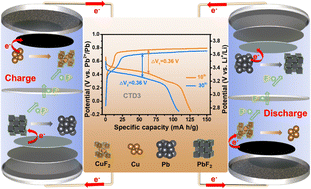Room-temperature reversible F-ion batteries based on sulfone electrolytes with a mild anion acceptor additive†
Abstract
Rechargeable fluoride ion batteries (FIBs) as an emerging anion shuttle system are attracting much attention due to their potential advantages in terms of energy density, cost and safety. A liquid electrolyte system enables the FIB operation at low or room temperature due to its higher ionic conductivity than that of a solid F-ion electrolyte. However, the insolubility of fluoride salts in aprotic solvents limits the development of liquid F-ion electrolytes. Although the boron-based anion acceptors (AAs) can facilitate the dissolution of F-ion salts, they are prone to lead to a tough desolvation process for F− due to strong Lewis acidity and therefore an inferior electrochemical performance. Here, a new non-boron AA (6-thioguanine) with moderate Lewis acidity is proposed to dissolve F− in the sulfone solvent. The ionic conductivity of the corresponding electrolytes reaches a level of mS cm−1 at room temperature. A model FIB coin cell is successfully operated with high conversion reaction reversibility based on the coupled defluorination/fluorination mechanism of electrodes, enabling a low overpotential of 0.36 V and a reversible capacity of 126 mA h g−1 after 40 cycles.



 Please wait while we load your content...
Please wait while we load your content...